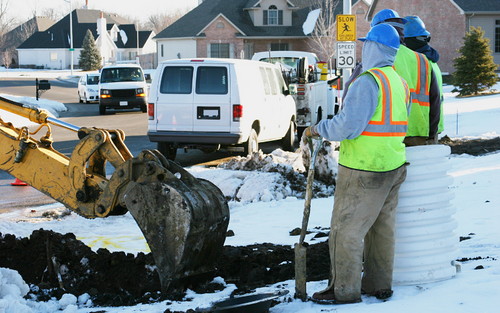Watch Out for These Common Cold-Weather Safety Hazards
Some jobs don’t stop when the weather gets bad—some jobs will even ramp up when the cold weather blows in. To those of you that are out working hard while the rest of the world is indoors, we salute you and want to help you take steps to avoid common cold-weather injuries and illnesses. Some cold-weather dangers are more obvious than others, but all can be deadly in the wrong circumstances. Here are five areas that need special attention while you’re working outside in low temps.
Illness and Injury
Cold stress can cause injuries and illnesses that are especially dangerous to workers. Frostbite, hypothermia, dehydration, snow blindness, and other hazards are very common when it gets cold out. Wearing the correct winter workwear and cold weather work gloves will help you avoid some of these hazards but so will proper training.
Take frequent breaks in a warm area to reduce the chance of developing frostbite or hypothermia. Stay hydrated by drinking water throughout the day—you may be exerting a lot of energy and sweating without realizing it. If you are stationed in one spot for long periods of time, maintain circulation by doing minor exercises that keep you moving and changing your position.
Driving and Traffic
There’s only so much that can be done about road conditions, so make sure you’re on the defensive and practicing safe driving behavior. Know what to do when you’re driving on snow and ice-covered roads, with proper training and licensure where appropriate. Ensure that your work vehicles have properly maintained brakes, cooling and electrical systems, engines, exhaust systems, tires, oil, and visibility systems. Keep an emergency kit inside all vehicles with supplies like emergency flares, snow brushes, jumper cables, blankets, and food and water.
You’re also at a much higher risk of being struck by vehicles or moving equipment when drivers skid and lose control on snow and ice. Keep work zones clearly marked with signs, cones, barrels, and barriers. Any workers that face hazards from traffic should wear high vis clothing to make sure other motorists see them.
Snow and Ice Removal
Shoveling snow is more strenuous than it seems—you can become exhausted and dehydrated without realizing it, and you can injure your back or even experience a heart attack from too much exertion. Take frequent breaks in warm areas, and warm up before you do any shoveling. Scoop small amounts at a time and push the snow rather than lifting it. If you must lift, lift with the legs while keeping your back straight. If your work involves removing snow from roofs, find a method that will clear the rooftop without workers if possible. If not, invest in the right equipment and PPE for the job.
Slips and Falls
After a winter storm hits, spread deicer on the ground as soon as possible. Wear proper footwear if you can’t avoid the slippery ground: insulated, water-resistant boots with good rubber treads are your best bet. You can also get rubber overshoes that fit over your street shoes. Walk more carefully by moving at a slower pace and taking shorter steps when conditions are slippery.
Equipment Issues
Wet conditions from snow and ice can reduce the insulation of your protective equipment, which can lead to electrocution. If you have to do repair or maintenance work on electrical gear, make sure it’s de-energized and that a hazard analysis has been done. Be aware of issues like carbon monoxide poisoning associated with poor ventilation, especially if you’re keeping warm in a vehicle. Don’t attempt to clear any jammed equipment by hand, especially if the unit is on or could become powered at any time.
Luckily, when you use PK Safety, you have a trusted workplace safety partner on your side. We carry safety gear that we would trust to keep us safe on the job, no matter where you work, what you do, or how cold it is while you’re doing it. For more information, contact a safety expert online or by phone at 800.829.9580.
Recent Posts
-
Customizing Gas Detectors: Tailoring Solutions to Fit Your Unique Requirements
In today’s diverse industrial landscape, a one-size-fits-all approach to safety simply doesn’t cu …Jul 3rd 2024 -
10 Ways to Prevent Wildfires
You can prevent wildfires by extinguishing flames before you leave the worksite. Avoid practicing …Jul 1st 2024 -
ANSI/ISEA 138 Safety Gloves: Ensuring Hand Protection
The human hand is an anatomical masterpiece and arguably the greatest tool attached to our bodies …Jun 25th 2024





